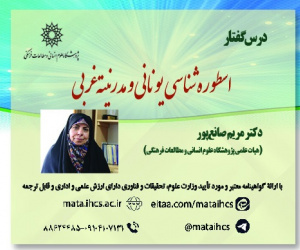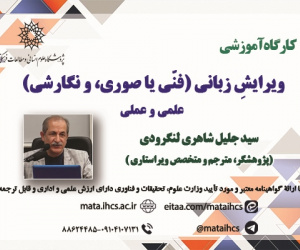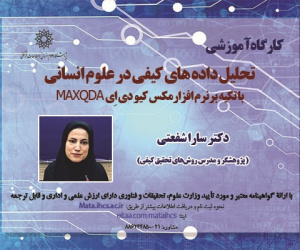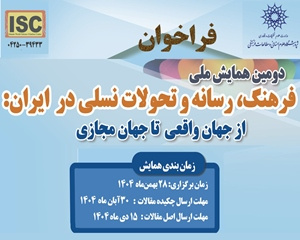تحلیل تصاویر کتاب چاپ سنگی دله مختار مبنی بر نقد تکوینی (مطالعه موردی: نسخه 1330ق)
آرشیو
چکیده
بیان مسئله با آغاز چاپ سنگی در ایران (۱۲۴۹ ه.ق)، انتشار کتاب به ویژه در موضوعات عامیانه رواج یافت. از نمونه های کتاب مصور به روش چاپ سنگی در دوره قاجار، داستان عامیانه "دله مختار" است که در کتابخانه مرکزی آستان قدس رضوی (شماره ثبت 2132) محفوظ است. این نسخه در ۱۳۳۰ ه.ق منتشر و دارای ۲۳ تصویر در متن داستان است. جهت دستیابی به اهداف پژوهش، با بهره گیری از روش نقد تکوینی - که در قرن بیستم میلادی شکل گرفته و مهم ترین هدف آن بررسی مراحل شکل گیری و آفرینش اثری هنری است - تصاویر مذکور بررسی خواهد شد. هدف پژوهش هدف پژوهش بررسی سیر تکوینی، شکل گیری و خلق تصاویر نسخه مذکور و واکاوی عوامل و هنجارهای تأثیرگذار (پیرامتن) است. این پژوهش به بررسی این موضوع می پردازد که هنرمند تا چه اندازه تحت تأثیر پیشامتن تصاویر (متن داستان) بوده و این عوامل به چه میزان در شکل گیری و خلق تصاویر تأثیرگذار بوده اند. سؤال پژوهش مراحل شکل گیری و آفرینش تصویرسازی های کتاب چاپ سنگی "دله مختار" (۱۳۳۰ ه.ق) بر اساس رویکرد نقد تکوینی و نگاره ویژه بر پیشامتن مکتوب (روایات) چگونه است؟ روش پژوهش این پژوهش با گردآوری داده ها بر اساس مطالعه کتابخانه ای و آرشیوی و روش تحقیق توصیفی-تحلیلی و رویکرد کیفی انجام می شود. نتیجه گیری هنرمند تحت تأثیر هنجارهای اجتماعی، سیاسی، فرهنگی، مذهبی و جنگ بین سنت و تجدد در زندگی روزمره قرار گرفته و در تصاویر، به خصوص از غرب، به ترسیم شکل های انسانی و حیوانی پرداخته است. پوشش افراد کاملاً قاجاری و متناسب با شأن و منزلت اجتماعی شان ترسیم شده و تزئینات متفاوتی برای لباس آنان به کار رفته است. با توجه به پیشامتن، تصویرگر برای پیکره ها در موقعیت های مختلف حالات روحی متفاوتی را طراحی کرده و با ایجاد تغییرات در حالات چهره و حرکات بدن شخصیت ها، احساسات مختلف را به نمایش گذاشته است. شخصیت ها نقش اصلی را در تصاویر دارند و فضاسازی ها بسیار محدود است. وجود رابطه قرینه بین متن و تصویر مشاهده می شود و پیرامتن ها هنجارهای موجود نیز نقش مهمی در خلق تصاویر داشته اند.An analysis on illustrations of Dale Mukhtar lithographic book based on formative criticism (Case study: the version 1330 AH)
Statement of the issue: With the beginning of lithography in Iran (1249AH), the publication of books, especially on popular subjects, became popular, and this literary genre could reflect the culture and customs of the Qajar period. Based on the literature and literature on the origins of the Nabazian novels, the decision has been made. Literary works that can be based, in a decision-making way, on the meaning and concept of a better way to address the statement of Kennand. For example, in the possession of Dastan, a picture taken from the text of Dastan, send a narration from Dastan to the addressee. There is a source of inspiration between Dastan Neez Bahtrin and the creation of his ideas for the sake of his images. The existence of any relatable link between the text and the illustration of a well-illustrated book is an important matter to be noticed. In these colloquial expressions, as well as verbal literature, in folk and ethnic groups, and in the context of the hurricane of religious, social, political, sectarian, and ... the religious, social, political, and sectarian spirits of this community are different from the viewpoints and sources of an important context. For the sake of poems with phrases, etiquette, and figures of peoples in different historical periods of Danest. From the presence of these dastans in the evidence of Dara Boden imagination and Magrajoyi, the love of Wiseh in the Nazd Mardm Dashth and Darand, with the entry of the Sanji chapter in Iran, a picture of it for the books of the Pedah Pedah Kurd Ta in the general studies of its decision-making and generation and its chapter Az A commercial view is a directive pattern. Among the examples of lithographic illustrated books in the Qajar period is the folk tale of Dale Mukhtar, preserved in the Astan Quds Razavi library. This version was published in 1330 AH and has 23 pictures next to the text of the story. By examining the images of these constitutions and their creation, and the factors influencing their creation, through a formative criticism that is important to the extent that they are established in the course of any formation that has been established by more images. In the direction of this in the compositional criticism, the final text (picturesazi), the result of the integration of the Pechamton and the importance of dividing the reading may begin and at the end of this text the end of the question in the choice of the addressee of the decision to be written. These are images for the first time in this book of the decision of Gharfthand and related to the body of the book of Hstand. Ramand photographed a photograph of a photographer in Yemen, a photographer. Midhem decision.Purpose: Examining the process of formation, formation and creation of the images of the mentioned edition and analyzing the influential factors and norms (paratext) and how much the artist was influenced by the pretext of the images (text of the story).Research question: What are the stages of formation and creation of the illustrations of Dele Mokhtar's lithographic book (1330 AH) based on the approach of critical and constructive criticism and special writing on the written pre-text (narratives)?Research method: data collection is based on library and archival study, descriptive-analytical research method and qualitative approach.Findings: The artist was influenced by social, political, cultural, religious norms and the war between tradition and modernity in his daily life, and in his pictures, especially in the naturalistic painting imported from the West, he drew human and animal figures, and the clothing of people was completely Qajar and According to their social status and the space they were in, different designs and decorations were used for their clothes. According to the pre-text, the illustrator has designed different moods for the figures in different situations and has displayed different emotions by making changes in the facial expressions and body movements of the characters. In the pictures, the main role is played by the characters and the space creations are very limited. The correlation between the text and the image can be seen. Paratexts and existing norms have also played an important role in creating images.








